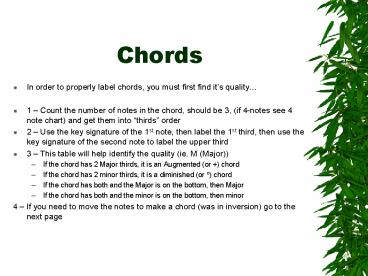Chords - PowerPoint PPT Presentation
1 / 3
Title: Chords
1
Chords
- In order to properly label chords, you must first
find its quality - 1 Count the number of notes in the chord,
should be 3, (if 4-notes see 4 note chart) and
get them into thirds order - 2 Use the key signature of the 1st note, then
label the 1st third, then use the key signature
of the second note to label the upper third - 3 This table will help identify the quality
(ie. M (Major)) - If the chord has 2 Major thirds, it is an
Augmented (or ) chord - If the chord has 2 minor thirds, it is a
diminished (or ?) chord - If the chord has both and the Major is on the
bottom, then Major - If the chord has both and the minor is on the
bottom, then minor - 4 If you need to move the notes to make a chord
(was in inversion) go to the next page
2
Inversions
- If the note is the Root (do) it is in root
position. It receives no special label. - If the note is the third (mi) it is in 1st
inversion. Label it as X6 - If the note is the fifth (sol) it is in 2nd
inversion. Label it as X
3
7th Chord Inversions
- If the note is the Root (do) it is in root
position. It receives no special label. - If the note is the third (mi) it is in 1st
inversion. Label it as X - If the note is the fifth (sol) it is in 2nd
inversion. Label it as X - If the note is the seventh (ti) it is in the
3rd inversion. Label it as X2































